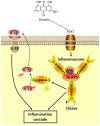Emodin attenuated severe acute pancreatitis via the P2X ligand‑gated ion channel 7/NOD‑like receptor protein 3 signaling pathway
- PMID: 30542707
- PMCID: PMC6278370
- DOI: 10.3892/or.2018.6844
Emodin attenuated severe acute pancreatitis via the P2X ligand‑gated ion channel 7/NOD‑like receptor protein 3 signaling pathway
Abstract
Acute pancreatitis (AP) is an aseptic inflammation characterized with an annual incidence rate, and ~20% patients progressing to severe AP (SAP) with a high mortality rate. Although Qingyi decoction has been frequently used for SAP treatment over the past 3 decades in clinic, the actual mechanism of its protective effects remains unknown. As the major active ingredient of Qingyi decoction, emodin was selected in the present study to investigate the effect of emodin against severe acute pancreatitis (SAP) in rats through NOD‑like receptor protein 3 (NLRP3) inflammasomes. The rats were randomly divided into a sham operation group, an SAP model group induced by a standard retrograde infusion of 5.0% sodium taurocholate into the biliopancreatic duct, and low‑dose (30 mg/kg) and high‑dose (60 mg/kg) emodin‑treated groups. At 12 h after the event, the plasma amylase, lipase, interleukin (IL)‑1β, IL‑18 and myeloperoxidase (MPO) activities were examined. Furthermore, the pathological scores of pancreases were evaluated by hematoxylin and eosin staining. The expression levels of P2X ligand‑gated ion channel 7 (P2X7), NLRP3, apoptosis‑associated speck‑like protein containing a C‑terminal caspase recruitment domain and caspase‑1 were also analyzed by western blot analysis. The data demonstrated that, compared with the SAP group, emodin could significantly relieve the pancreatic histopathology and acinar cellular structure injury, and notably downregulate the plasma amylase and lipase levels, as well as the MPO activities in pancreatic tissues, in a dose‑dependent manner. Furthermore, emodin inhibited the P2X7/NLRP3 signaling pathway followed by the decrease of pro‑inflammatory factors, and the latter is beneficial for the recovery of SAP. Collectively, the data indicated that emodin may be an efficient candidate natural product for SAP treatment.
Figures






Similar articles
-
Emodin alleviates intestinal mucosal injury in rats with severe acute pancreatitis via the caspase-1 inhibition.Hepatobiliary Pancreat Dis Int. 2017 Aug 15;16(4):431-436. doi: 10.1016/S1499-3872(17)60041-9. Hepatobiliary Pancreat Dis Int. 2017. PMID: 28823375
-
Pharmacokinetics and pharmacodynamics of Shengjiang decoction in rats with acute pancreatitis for protecting against multiple organ injury.World J Gastroenterol. 2017 Dec 14;23(46):8169-8181. doi: 10.3748/wjg.v23.i46.8169. World J Gastroenterol. 2017. PMID: 29290653 Free PMC article.
-
Emodin has a protective effect in cases of severe acute pancreatitis via inhibition of nuclear factor‑κB activation resulting in antioxidation.Mol Med Rep. 2015 Feb;11(2):1416-20. doi: 10.3892/mmr.2014.2789. Epub 2014 Oct 27. Mol Med Rep. 2015. PMID: 25351888
-
Perspectives of traditional Chinese medicine in pancreas protection for acute pancreatitis.World J Gastroenterol. 2017 May 28;23(20):3615-3623. doi: 10.3748/wjg.v23.i20.3615. World J Gastroenterol. 2017. PMID: 28611514 Free PMC article. Review.
-
The Effects of NLRP3 Inflammasome Inhibition in Experimental Acute Pancreatitis: A Systematic Review and Meta-Analysis.Pancreas. 2022 Jan 1;51(1):13-24. doi: 10.1097/MPA.0000000000001971. Pancreas. 2022. PMID: 35195590
Cited by
-
Effects of Anthraquinones on Immune Responses and Inflammatory Diseases.Molecules. 2022 Jun 14;27(12):3831. doi: 10.3390/molecules27123831. Molecules. 2022. PMID: 35744949 Free PMC article. Review.
-
Zengye Decoction Attenuated Severe Acute Pancreatitis Complicated with Acute Kidney Injury by Modulating the Gut Microbiome and Serum Amino Acid Metabolome.Evid Based Complement Alternat Med. 2022 May 9;2022:1588786. doi: 10.1155/2022/1588786. eCollection 2022. Evid Based Complement Alternat Med. 2022. PMID: 35586694 Free PMC article.
-
NLRP3 Inflammasome-Mediated Inflammation in Acute Pancreatitis.Int J Mol Sci. 2020 Jul 29;21(15):5386. doi: 10.3390/ijms21155386. Int J Mol Sci. 2020. PMID: 32751171 Free PMC article. Review.
-
Purinergic receptor ligands: the cytokine storm attenuators, potential therapeutic agents for the treatment of COVID-19.Immunopharmacol Immunotoxicol. 2021 Dec;43(6):633-643. doi: 10.1080/08923973.2021.1988102. Epub 2021 Oct 14. Immunopharmacol Immunotoxicol. 2021. PMID: 34647511 Free PMC article. Review.
-
Drug discovery and formulation development for acute pancreatitis.Drug Deliv. 2020 Dec;27(1):1562-1580. doi: 10.1080/10717544.2020.1840665. Drug Deliv. 2020. PMID: 33118404 Free PMC article. Review.
References
MeSH terms
Substances
LinkOut - more resources
Full Text Sources
Medical
Research Materials
Miscellaneous

